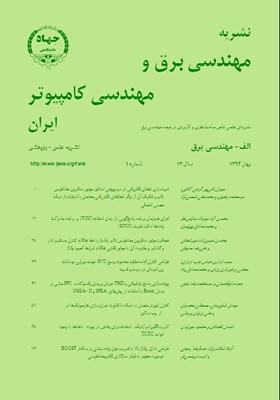بررسی احتمال خطای پروتکل دیکد- تقویت- ارسال با انتخاب بهترین و n امین بهترین رله در شبکههای همیار با رلههای موازی
محورهای موضوعی : مهندسی برق و کامپیوتر
1 - دانشگاه تهران
2 - دانشگاه تهران
کلید واژه: احتمال خطای بیت دایورسیتی رله مخابرات همیار,
چکیده مقاله :
دایورسیتی فضایی یکی از مؤثرترین روشهای موجود برای مقابله با پدیده محوشدگی در کانالهای مخابراتی بیسیم میباشد که از طریق ایجاد آرایههای آنتنی قابل حصول است. در این مقاله به بررسی پروتکل دیکد- تقویت- ارسال با انتخاب بهترین رله (HDAF-S) بر روی سیستم همیار با دایورسیتی با چندین رله موازی بر روی کانالهای مستقل ولی با توزیع غیر یکسان پرداخته و کرانهای بالا و پایین بسیار محکمی را برای احتمال خطای بیت این طرح به دست آورده و نشان میدهیم که احتمال خطای بیت این طرح از تقویت- ارسال (AF) بهتر عمل نموده ولی نمیتواند از دیکد- ارسال (DF) بهتر عمل نماید. سپس به بررسی عملکرد مجانبی این طرح در سیگنال به نویزهای بالا پرداخته و نشان میدهیم که این طرح دارای مرتبه دایورسیتی کامل میباشد. بعد از آن به احتمال خطای بیت HDAF با انتخاب n امین بهترین رله (HDAF-nS) روی کانالهای مستقل و با توزیع احتمال یکسان پرداخته و کرانهای بالا و پایین بسیار محکمی را نیز برای این طرح به دست آورده و همچنین رفتار مجانبی آنها بررسی مینماییم و نشان میدهیم که این طرح دارای مرتبه دایورسیتی کامل نمیباشد و همچنین در این طرح با افزایش n، مرتبه دایورسیتی کاهش مییابد. برای هر طرح مورد بحث، نتایج عددی و شبیهسازی فراهم آمده تا مقایسه جامعی از این طرحها با طرحهای مرسوم در ادبیات مخابرات همیار به عمل آید.
Spatial diversity is one of the most effective techniques to combat fading in wireless channels that can be implemented through antenna arrays. In this paper the hybrid decode-amplify-forward protocol with best relay selection (HDAF-S)in a cooperative system with multiple parallel relays with independent non-identically channels is considered and tight upper and lower bounds on bit error rate (BER) of this protocol is derived. It is shown that the BER of this protocol outperforms the BER of amplify and forward (AF) protocol but cannot exceeds the performance of decode and forward (DF) protocol. Then through asymptotic analysis for high SNR regime, it is shown that the HDAF-S protocol achieves full diversity order. Then the BER performance of HDAF protocol with n-th best relay selection (HDAF-nS) in independent and identically distributed channels is analyzed and tight upper and lower bounds on the BER are derived. Asymptotic analysis shows that this protocol cannot achieve full diversity order and it is shown that the diversity order decreases as n increases. The analytical results are validated through simulations.
[1] J. N. Laneman, D. N. C. Tse, and G. W. Wornell, "Cooperative diversity in wireless networks: efficient protocols and outage behavior," IEEE Trans. Inform. Theory, vol. 50, no. 12, pp. 3062-3080, Dec. 2004.
[2] A. Sendonaris, E. Erkip, and B. Aazhang, "User cooperation diversity, Part I, system description," IEEE Trans. Commun., vol. 51, no. 11, pp. 1927-1938, Nov. 2003.
[3] A. Sendonaris, E. Erkip, and B. Aazhang, "User cooperation diversity, Part II, implementation aspects and performance analysis," IEEE Trans. Commun., vol. 51, no. 11, pp. 1939-1948, Nov. 2003.
[4] T. Q. Duong and H. J. Zepernick, "On the performance gain of hybrid decode-amplify-forward cooperative communications," EURASIP J. on Wireless Comm. and Networking, vol. 2009, 10 pp, 15 Jun. 2009.
[5] Y. Li and B. Vucetic, "On the performance of a simple adaptive relaying protocol for wireless relay networks," in Proc. of Vehicular Technology Conf., VTC, vol. ???, pp. 2400-2405, Singapore, 11-14 May 2008.
[6] E. Olfat and A. Olfat, "Performance of hybrid decode - amplify - forward protocol for multiple relay networks over independent and non - identical flat fading Channels," IET Communications, vol. 5, no. 4, pp. 2018-2027, Sep. 2011.
[7] S. S. Ikki and M. H. Ahmed, "On the performance of amplify-and-forward cooperative diversity with the Nth best-relay selection scheme," in Proc. of 2009 IEEE Int. Conf. on Commun. (ICC), 6 pp., Dresden, Germany, 14-18 Jun. 2009.
[8] S. S. Ikki and M. H. Ahmed, "On the performance of adaptive decode-and-forward cooperative diversity with the Nth best-relay selection scheme," in Proc. of the 28th IEEE Conf. on Global Telecommunications, 6 pp., Honolulu, HI, US, 30 Nov.-4 Dec. 2009.
[9] M. K. Simon and M. S. Alouini, Digital Communications over Fading Channels, 2nd Edition, New York: Wiley- Interscience, 2005.
[10] N. C. Beaulieu and J. Hu, "A closed - form expression for the outage probability of decode - and - forward relaying in dissimilar rayleigh fading channels," IEEE Commun. Lett., vol. 10, no. 12, pp. 813-815, Dec. 2006.
[11] T. Nechiporenko, K. T. Phan, C. Tellambura, and H. H. Nguyen, "On the capacity of rayleigh fading cooperative systems under adaptive transmission," IEEE Trans. on Wireless Communications, vol. 8, no. 4, pp. 1626-1631, Apr. 2009.
[12] P. A. Anghel and M. Kaveh, "Exact symbol error probability of a cooperative network in a rayleigh - fading environment," IEEE Trans. on Wireless Communications, vol. 3, no. 5, pp. 1416-1421, Sep. 2004.
[13] Z. Wang and G. B. Giannakis, "A simple and general parameterization quantifying performance in fading channels," IEEE Trans. on Communications, vol. 51, no. 8, pp. 1389-1398, May 2003.
[14] A. Ribeiro, X. Cai, and G. B. Giannakis, "Symbol error probabilities for general cooperative links," IEEE Trans. on Wireless Communications, vol. 4, no. 3, pp. 1264-1273, May 2005.


